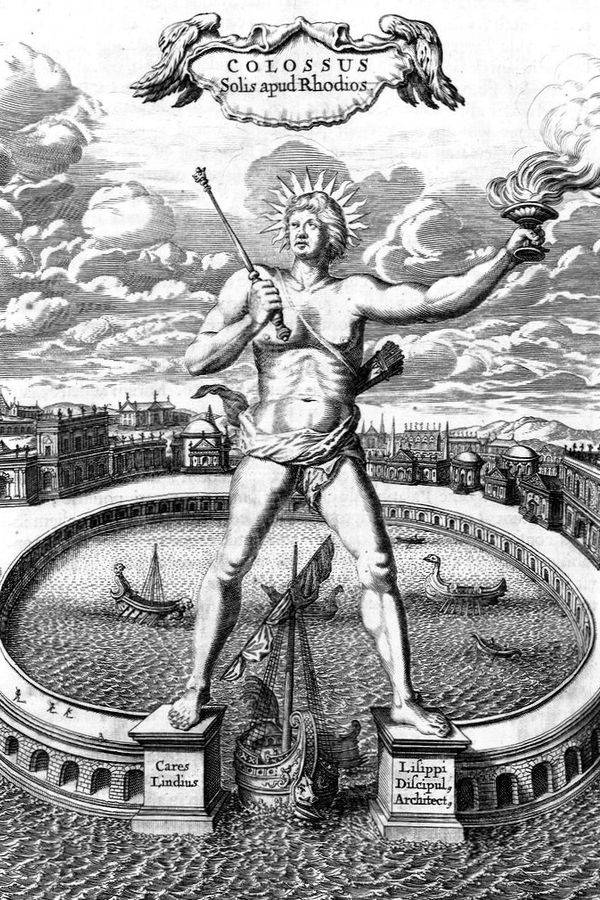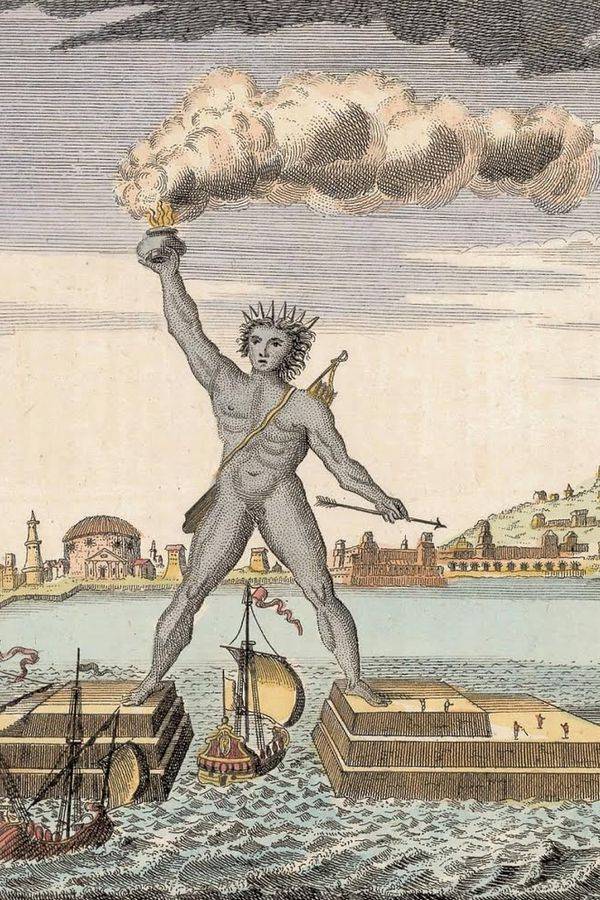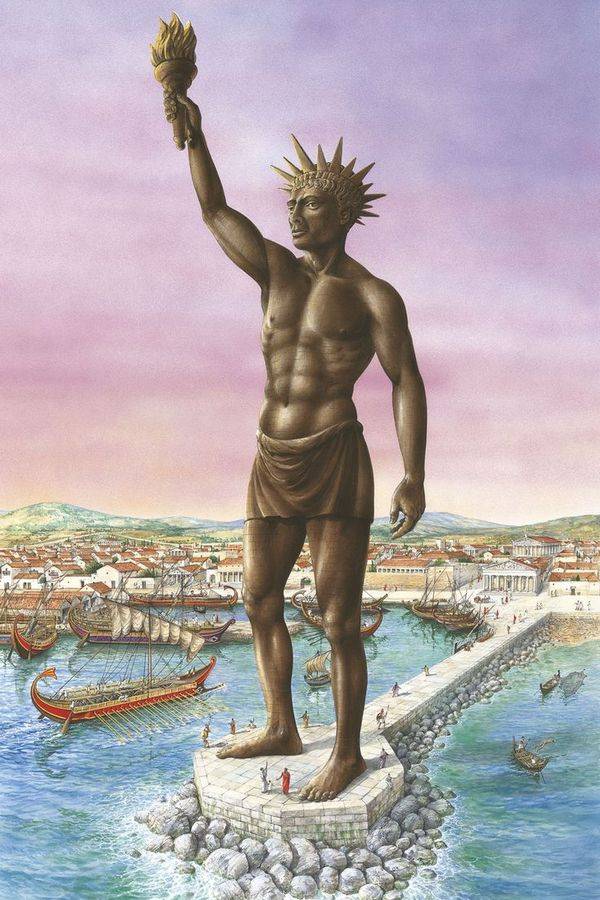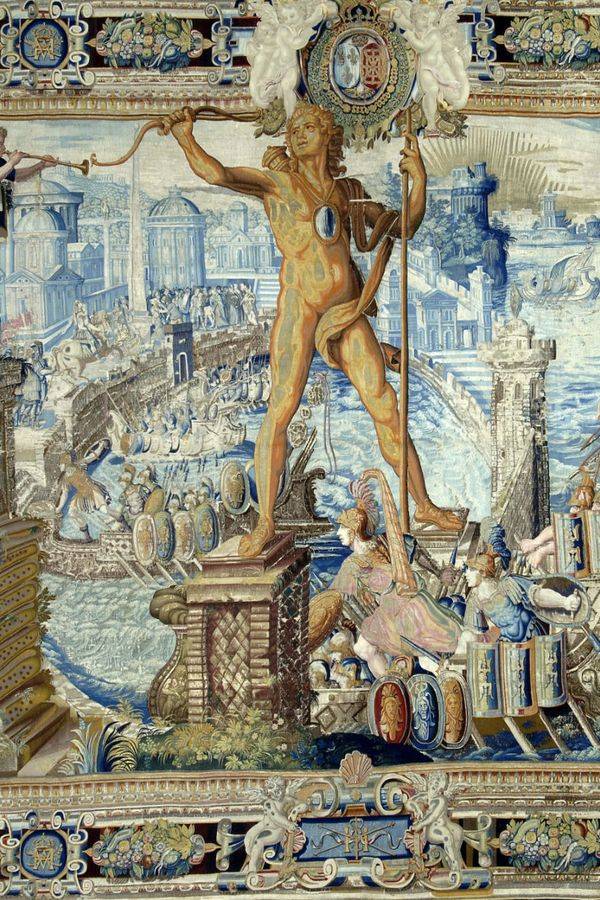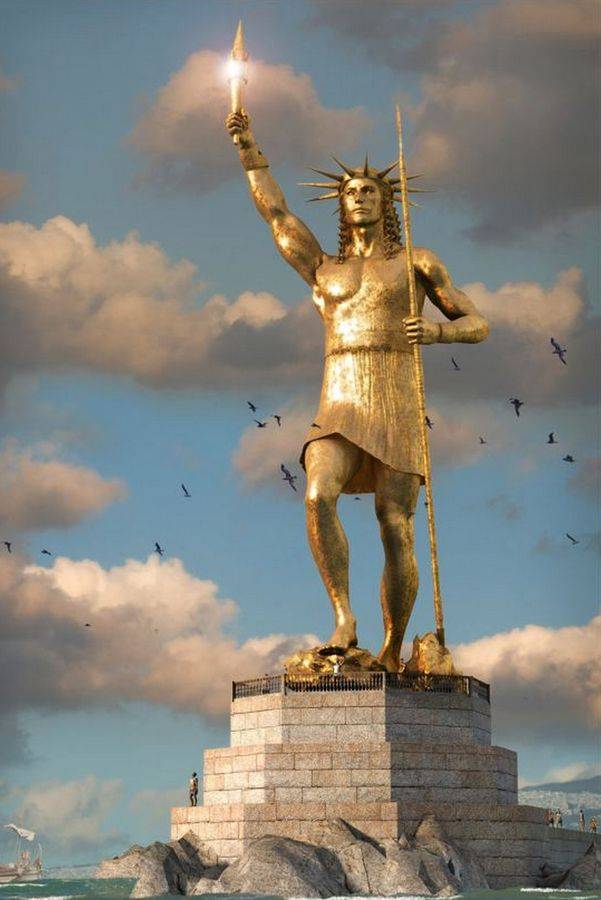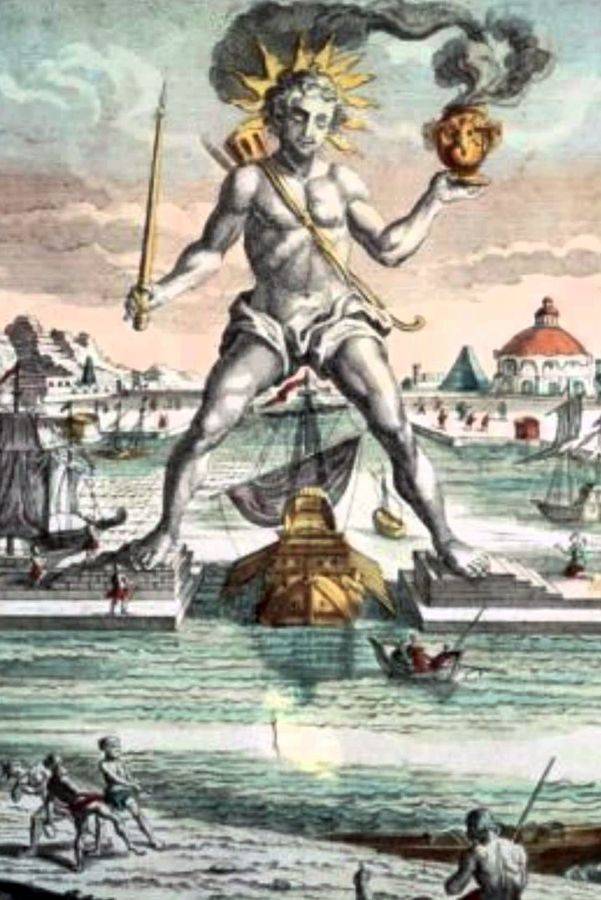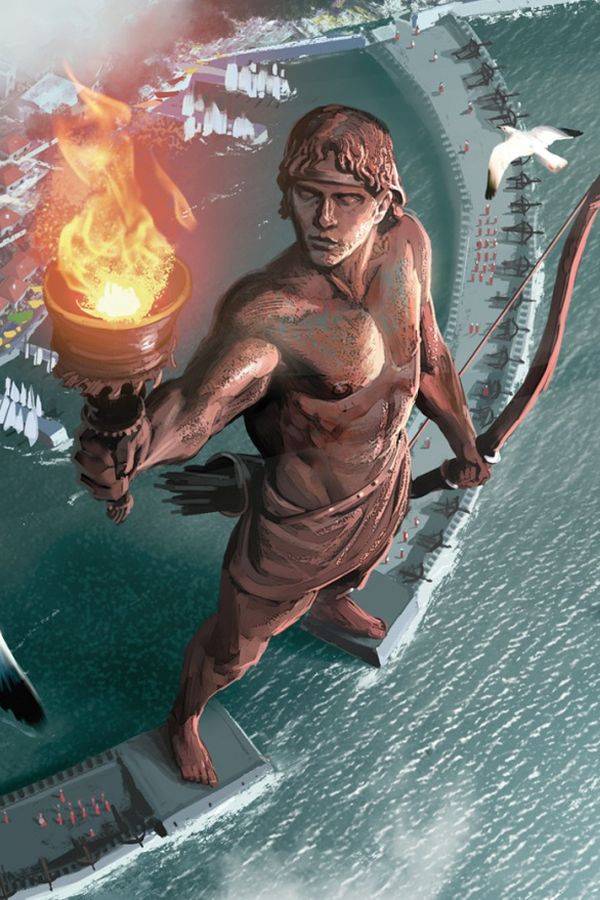The colossus of Rhodes was a gigantic statue located near the port of the city of Rhodes, the main town of the island of the same name. It is located in the Mediterranean, in the Aegean Sea, near the Turkish coast and is the largest of the Greek islands of this sea. The statue was Elios, God of the Sun, it was begun in 292 BC for a period of construction of 12 years. It holds the sad record of the world's shortest wonder: 60 years later it was already demolished, where the pyramid of Cheops is still standing despite its 4,500 years.
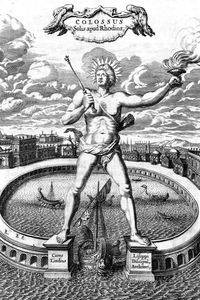
Colossus of Rhodes
Description of the colossus
With such a short life it is difficult to know exactly what this statue looked like. However, its popularity was such that it was described and reproduced several times, and by crossing this information it came to be known that it was an almost naked man wearing a crown of solar rays on his head and brandishing a torch. It was 32m high and was made of bronze, except the pedestal and feet, on which it was mounted, which were of marble, a material renowned for its solidity.
It is said that the face of the colossus of Rhodes was that of Alexander the Great, but it is impossible to confirm or disprove it. However, this is unlikely.
Location
Rhodes is the largest Greek island in the Dodecanese archipelago. It is only 19 km away from the Turkish coast. The port of the capital, also named Rhodes is the place where the statue was located but no one knows the exact location. The archaeological excavations have not yet given anything, which is hardly surprising since the site had to be much smaller than, for example, the site of the temple of Artemis. Moreover once collapsed the statue remained in the state for a long time, then the site was cleared. It is probably that the urbanization of Rhodes and its harbor was due to the hypothetical vestiges, which makes it impossible to know precisely where it was today.
What we can say is that the city of Rhodes was protected by a rampart of 15Km long and a wide ditch, forcing the assailants to use a tower to enter the city, and that the city possessed a large temple already dedicated to Helios. It must be said that this God was the protector of Rhodes. Some people think that the statue was located near this temple, but the representations that have come down to us indicate that it was rather at the entrance to the port.
Several representations show a statue spanning the entrance to the port. Such a configuration could not be envisaged because it was more than 30m high, and if the proportions were correct - and there is no reason to believe the contrary - the small width allowed by the spacing of the legs would have caused a unacceptable shrinkage of port entrance. Moreover, she would simply not have stood up, it is physically impossible. And finally, if it had been so done, it would have collapsed in the entrance of the harbor and not on the mainland, as it is attested to be. This hypothesis is therefore to be analyzed.
Learn more about the Location of the colossus.
History
Reasons of the construction
The reason why the Rhodanians built this tower is simple, following a victory they won in 304. That year the island survived a terrible siege caused by Demetrios Poliorcete, Alexander the Great, who had received the order of Antigonus to become master of the Mediterranean and to assert his dominion over the Greek islands. The siege was held for a year, between 305 and 304 BC, and was held by Rhodes, engendering the satisfaction of the inhabitants who saw a divine will, especially since it was the third seat in only 30 years. To thank the protective God Helios, they decided to build a gigantic statue, it is as simple as that.
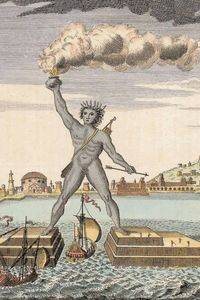
Colossus of Rhodes
It should be noted that during the Antiquity the island of Rhodes was famous for its statues, and according to the Roman author Pliny, the capital was proud to possess 3000, often in stone, sometimes in bronze, but if the quantity of statues of the island made it a characteristic, it did not yet possess gigantic statues, a titanic statue as they are called today. The city of Olympus had one, it was made by Phidias, Greek sculptor who conceived the Statue of Zeus, a chryséléphantine statue of 13m high, another of the 7 wonders of the world. He had previously made the statue of Athena, another chryshephantine statue, but this one was a little smaller, only 9m. Previously, other nations have produced gigantic statues, Rhodes had to have his own, and the opportunity had come.
Funding
Funding has been rather original, it is the first time that has happened in the history of humanity, at least for the major works of which we know the financing: Money was found by selling the military equipment abandoned on the ground by Demetrios Poliorcete who, with 40,000 soldiers, had led the attack on the capital of the island. It should be known that during the 4th century BC Rhodes experienced a major economic boom. She had allied with King Ptolemy Soter I of Egypt. In 305 BC the Antogonids of Macedonia, who were rivals to the Ptolemies, attacked the island but without success. It was from this battle that the military equipment that was used to finance the colossus was recovered.
There is no doubt that other funding had to be found, but it is not known in what proportion it was or who contributed it. Often in such a case it is the people who abound to build the monument that will ensure the aura of the city.
The sculptor, Charès de Lindos
The sculptor of the Colossus of Rhodes is well known, it is Chares of Lindos. Lindos is simply one of the three major cities of Rhodes.
Chares was a follower of a realistic style, as was Phidias, the sculptor of the Statue of Zeus, another of the wonders of the world. This style is much more complex to implement because it requires a great mastery in the reproduction of a character. This style allows to magnify the realism of the statue and to translate the force and the movement.
The construction
The construction of the Colossus of Rhodes began in 292 BC and continued until 280 BC, ie a duration of work of only 12 years. For a statue more than 30m high and techniques of works of antiquity, it can be said that the site did not drag.
The base of the construction was a marble base, a particularly solid material. On this base the workers stacked roughly cut stones to create the feet, then the legs, then the rest of the body. This formed a statue of unharmonious but solid form. Other workers then intervened to secure the stones of a band of iron tightly, at regular intervals, over the whole height of the statue. This strapping served as an intermediary, on which were fixed the bronze plates that dressed the statue.
Bronze is a mixture of iron and copper. The copper came from Cypriot mines from which the ore was mined. This work was particularly painful, as the galleries were not as secure as they are today. Once out it was heated to separate the copper from the rocks, then melted into ingots. It was these ingots that were transported to the site.
To make the bronze plates, the copper was first melted in large ovens, and the iron was then added to 10 to 20%. Then the mixture was transported in kinds of ladles that they used to distribute the metal in clay molds, flat molds to form sheets more or less thick according to the needs. The molds could be used several times, but did not have a long life. The next step was to remove the rough edges and then to polish the plates before transporting them to the site where they were recovered, hammered to the desired shape and then assembled on the iron structure and to the other plates by pegs. The plates of the feet and ankles were special, they were only molded (because of their shapes) and probably had to weigh heavier than the others to ensure the stability of the whole.
Thus the colossus of Rhodes was only covered with a thin film of bronze, its body being made of stone. Each plate was fixed on the iron frame and then on the neighboring plate. The colossus took pitch from day to day, until the top of the head was reached. Once finished, it was polished so that the Sun would make it shine as intensely as possible.
It should be noted that this construction technique is quite similar to that used for the construction of the Statue of Liberty in New York. But apart from the fact that the latter has a metallic structure (made by Gustave Eiffel), it is made of a copper plate held on the structure by iron rods. And for the record, know that when copper rubs on iron, it causes electricity, especially in a marine environment heavily loaded with salt. One can imagine that, like the statue of Liberty, the Colossus of Rhodes made its own electricity!
Materials choice
The choice of bronze was not made at random, it was on the contrary very studied. It is an alloy between copper and iron. Stronger than iron, it resists extreme weather conditions. It is therefore well suited to the manufacture of statues to be exposed to the outside, and in particular to sea air laden with salt.
Destruction
Alas, the Colossus of Rhodes is the marvel of the ancient world which had the shortest life: Barely 60 years old, almost. It must be said that the shape of the statue, its gigantism for the time and the means used for its construction contributed to make it ephemeral. A statue of 30m representing a character is inevitably more fragile than the pyramid of Cheops, the form of which is the most stable of the existing forms.
The colossus of Rhodes was destroyed during a large-scale earthquake in 226 BC. Broken at the knees, she collapsed and fell apart. The pieces remained on the spot for 800 years, it is not known for what reason, but it is established that in 654 AD the Arabs, who invaded Rhodes, sold the bronze to a Syrian merchant. The metal was transported on the back of 900 camels and it is since that nothing remains of this statue.
Some representations
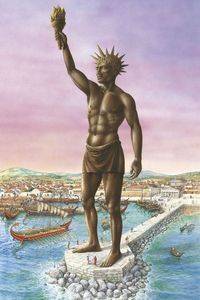
Colossus of Rhodes
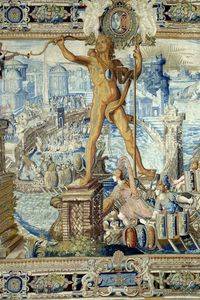
Colossus of Rhodes
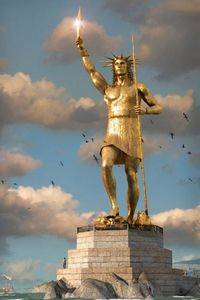
Colossus of Rhodes
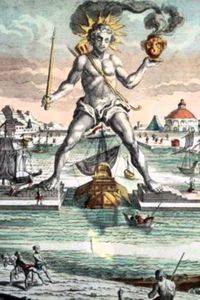
Colossus of Rhodes
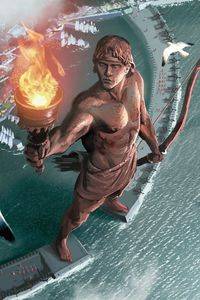
Colossus of Rhodes
Symbolism
Beyond a desire to please the God Helios, the protector of Rhodes, the inhabitants knew that building the largest statue ever made on Earth would increase the prestige of their island. The political will to mark the spirits is evident and in this way joined the Lighthouse of Alexandria which was also built, besides serving as a lighthouse, to show the prestige of Egypt.
Otherwise we must know that the Colossus of Rhodes was one of the main inspirations of the Statue of Liberty.
See also:





